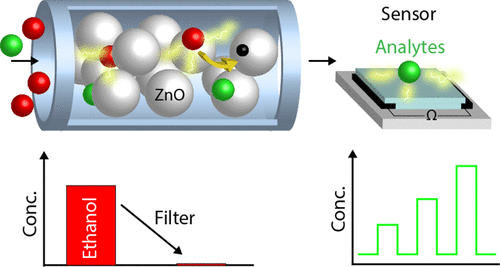Our official English website, www.x-mol.net, welcomes your
feedback! (Note: you will need to create a separate account there.)
Catalytic Filter for Continuous and Selective Ethanol Removal Prior to Gas Sensing.
ACS Sensors ( IF 8.2 ) Pub Date : 2020-03-16 , DOI: 10.1021/acssensors.9b02572 Andreas T Güntner 1, 2 , Ines C Weber 1 , Sotiris E Pratsinis 1
ACS Sensors ( IF 8.2 ) Pub Date : 2020-03-16 , DOI: 10.1021/acssensors.9b02572 Andreas T Güntner 1, 2 , Ines C Weber 1 , Sotiris E Pratsinis 1
Affiliation

|
Ethanol is a major confounder in gas sensing because of its omnipresence in indoor air and breath from disinfectants or alcoholic beverages. In fact, most modern gas sensors (e.g., graphene, carbon nanotubes, or metal oxides) are sensitive to ethanol. This is challenging because ethanol is often present at higher concentrations than target analytes. Here, a simple and modular packed bed filter is presented that selectively and continuously removes ethanol (and other alcohols like 1-butanol, isopropanol, and methanol) over critical acetone, CH4, H2, toluene, and benzene at 30-90% relative humidity. This filter consists of catalytically active ZnO nanoparticles (dBET = 55 nm) made by flame aerosol technology and annealing. Continuous oxidation of ethanol to CO2 and H2 was observed at filter temperatures above 260 °C while below that, unwanted acetaldehyde was formed. Most remarkably, ethanol concentrations up to 185 ppm were removed from exhaled breath in preliminary tests with an alcohol intoxicated volunteer, as confirmed by mass spectrometry. At the same time, almost 4 orders of magnitude lower (e.g., 0.025 ppm) acetone concentrations were preserved. This was superior to previous catalyst filters (e.g., CuO, SnO2, and Fe2O3) with overlapping ethanol and acetone conversions and related to ZnO's surface basicity. The ZnO filter performance was stable (±2.5% conversion variability) for, at least, 21 days. Finally, when combined with a Si-doped WO3 sensor, the filter effectively mitigated ethanol interference when sensing acetone without compromising the sensor's fast response and recovery times. Such catalytic filters can be combined readily with all gas sensors.
中文翻译:

用于在气敏之前连续和选择性去除乙醇的催化过滤器。
乙醇是气体检测的主要混杂因素,因为它在室内空气中无处不在,并且来自消毒剂或酒精饮料的呼吸。实际上,大多数现代气体传感器(例如石墨烯,碳纳米管或金属氧化物)对乙醇很敏感。这具有挑战性,因为乙醇的浓度通常高于目标分析物。在这里,提出了一种简单的模块化填充床过滤器,该过滤器在相对湿度为30-90%的条件下,在临界丙酮,CH4,H2,甲苯和苯上有选择地连续除去乙醇(以及其他醇,例如1-丁醇,异丙醇和甲醇) 。该过滤器由通过火焰气溶胶技术和退火制成的具有催化活性的ZnO纳米颗粒(dBET = 55 nm)组成。在高于260°C的过滤器温度下观察到乙醇不断氧化为CO2和H2,低于此温度,形成不需要的乙醛。最显着的是,在初步测试中,用酒精中毒的志愿者从呼气中除去了高达185 ppm的乙醇,这已通过质谱法得到证实。同时,保留了几乎低四个数量级(例如0.025 ppm)的丙酮浓度。这优于先前的催化剂过滤器(例如,CuO,SnO2和Fe2O3)具有重叠的乙醇和丙酮转化率,并且与ZnO的表面碱性有关。ZnO过滤器性能至少在21天内稳定(转换差异为±2.5%)。最后,当与掺Si的WO3传感器结合使用时,该过滤器可有效减轻乙醇在感测丙酮时的干扰,而不会影响传感器的快速响应和恢复时间。这种催化过滤器可以很容易地与所有气体传感器结合使用。
更新日期:2020-03-16
中文翻译:

用于在气敏之前连续和选择性去除乙醇的催化过滤器。
乙醇是气体检测的主要混杂因素,因为它在室内空气中无处不在,并且来自消毒剂或酒精饮料的呼吸。实际上,大多数现代气体传感器(例如石墨烯,碳纳米管或金属氧化物)对乙醇很敏感。这具有挑战性,因为乙醇的浓度通常高于目标分析物。在这里,提出了一种简单的模块化填充床过滤器,该过滤器在相对湿度为30-90%的条件下,在临界丙酮,CH4,H2,甲苯和苯上有选择地连续除去乙醇(以及其他醇,例如1-丁醇,异丙醇和甲醇) 。该过滤器由通过火焰气溶胶技术和退火制成的具有催化活性的ZnO纳米颗粒(dBET = 55 nm)组成。在高于260°C的过滤器温度下观察到乙醇不断氧化为CO2和H2,低于此温度,形成不需要的乙醛。最显着的是,在初步测试中,用酒精中毒的志愿者从呼气中除去了高达185 ppm的乙醇,这已通过质谱法得到证实。同时,保留了几乎低四个数量级(例如0.025 ppm)的丙酮浓度。这优于先前的催化剂过滤器(例如,CuO,SnO2和Fe2O3)具有重叠的乙醇和丙酮转化率,并且与ZnO的表面碱性有关。ZnO过滤器性能至少在21天内稳定(转换差异为±2.5%)。最后,当与掺Si的WO3传感器结合使用时,该过滤器可有效减轻乙醇在感测丙酮时的干扰,而不会影响传感器的快速响应和恢复时间。这种催化过滤器可以很容易地与所有气体传感器结合使用。











































 京公网安备 11010802027423号
京公网安备 11010802027423号